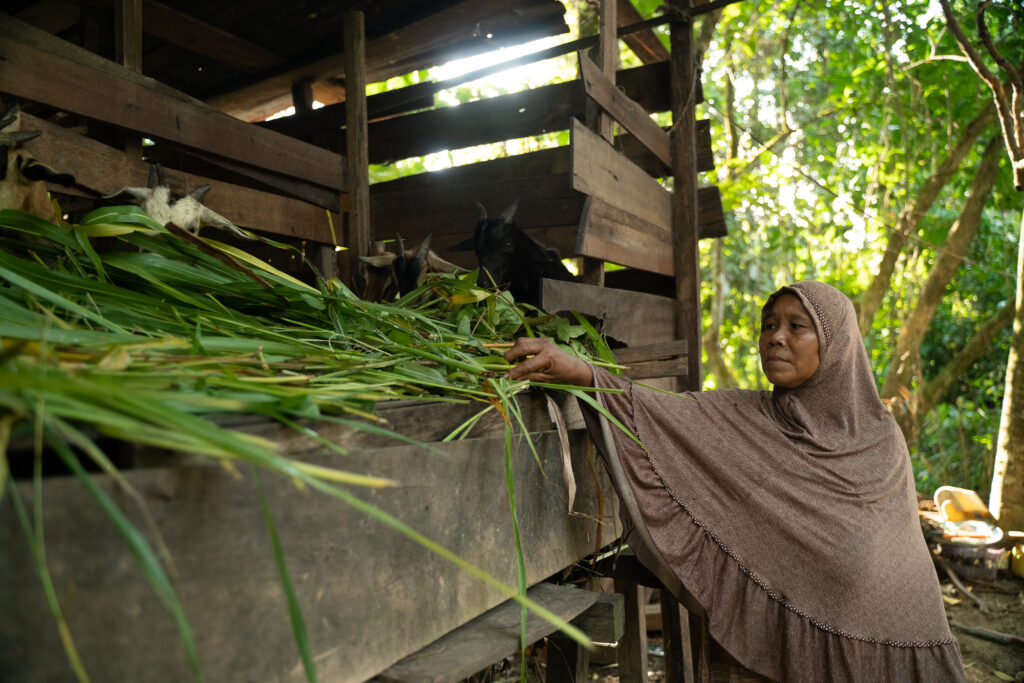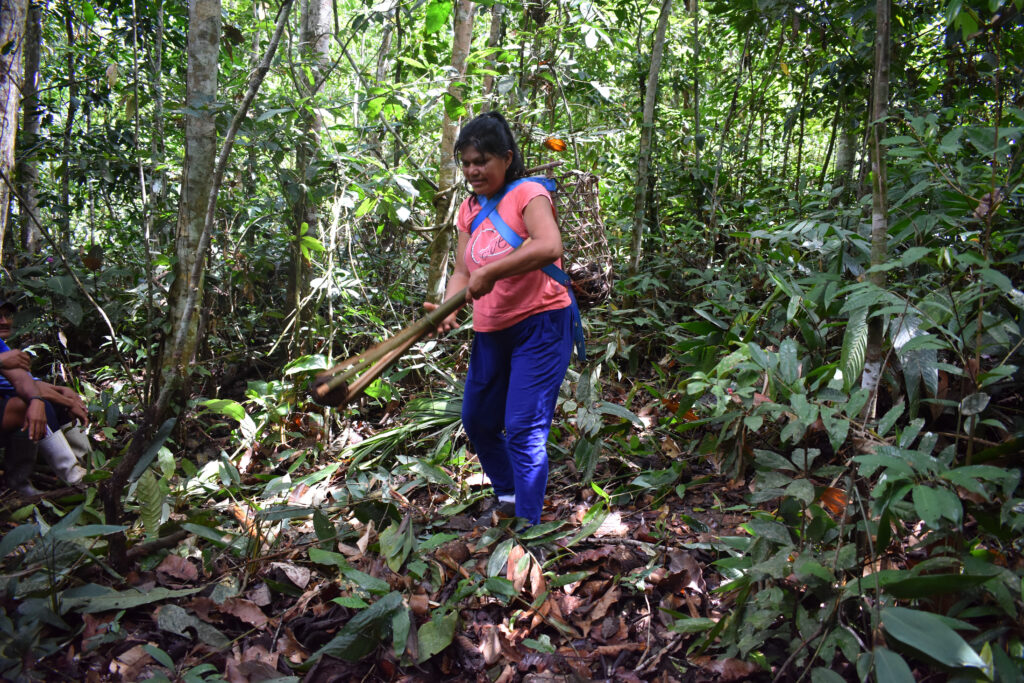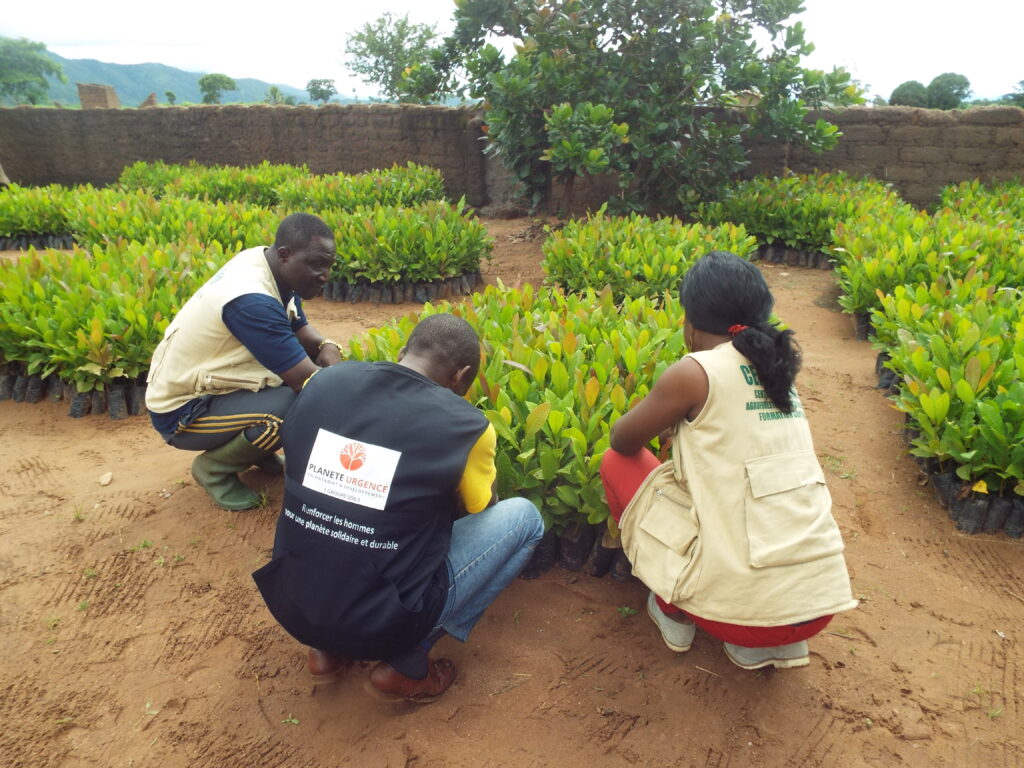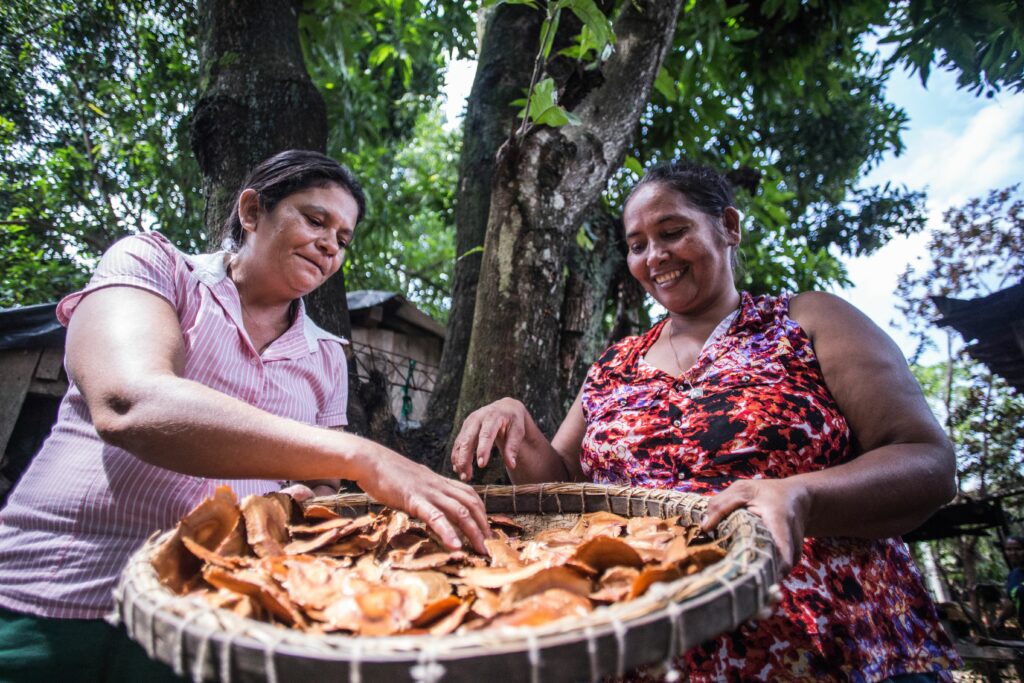Guardians of the land: Supporting Climate Action by Indigenous Peoples
Introduction
Human activity has put nature under intense strain, and close to collapse in many parts of the world. One million plant and animal species are now threatened with extinction. Given the vital role forests and wetlands play absorbing carbon, the impact on our climate could be catastrophic.
At Ashden we recognise this urgency and need, which is why we support ‘on the ground’ innovations that actively work with the natural world to protect it and the support the livelihoods of its custodians. We know that Indigenous communities are among the most effective stewards of nature – supporting them is key to protecting and restoring nature.
This report explores some of the outstanding initiatives that empower Indigenous People to live with dignity and economic security – and reveals what makes them so successful. From cashew farming in Cameroon to a goats for widows scheme in Indonesia, these projects create employment opportunities, strengthens the incomes and rights of threatened communities, allowing them to live sustainably and be strong stewards of their ancestral homes.
But such trailblazing natural climate solutions will only survive, thrive and spread with increased global action.
We need to see an increased flow of funding from the global north to the global south. This finance must flow to locally led action by Indigenous people and local communities, whereby the fair distribution of the benefits of nature is central to their success. The following case studies show just how effective this approach can be.
This approach should be supported by international regulation and legalisation, whereby countries are incentivised for investing in nature, food security and livelihoods, and penalised if they don’t.
All the initiatives highlighted in this report are winners or finalists of the Ashden Award for Natural Climate Solutions – an annual prize for outstanding work in this area, supporting pioneers with grants, publicity and opportunities. Ashden’s rigorous assessment process has confirmed the quality and potential of these initiatives, and their potential to be scaled up or replicated. Each case study is unique but collectively they provide a hallmark to donors and funders for what good nature based solutions should look like.
Case study: Alam Sehat Lestari, Indonesia

Alam Sehat Lestari (ASRI) has been working with Indigenous communities in Indonesian Borneo to reverse illegal logging and deforestation for more than 15 years.
The NGO has designed solutions to the problem, in collaboration with local people, bringing benefits such as alternative sources of income and a clinic providing high-quality affordable healthcare. Examples of its work include a scheme allowing people to trade in their chainsaws in return for investment in a new, more sustainable, businesses.
ASRI first used this approach in an area surrounding the Gunung Palung National Park – where after ten years they have reduced illegal logging by 90% and infant mortality by 67%. ASRI has also contributed to the replanting of 284 hectares of land.
In their site, ASRI has been providing healthcare which families can pay for using goods such as seedlings and manure. These are then used to reforest degraded land within the community. As a result, communities have seen a significant fall in diseases, including tuberculosis and malaria.
The innovative chainsaw buy-back entrepreneurship programme offers no-interest investment funds to help people transition to less destructive livelihoods. New businesses are supported with financial, marketing and business plan training – popular activities include beekeeping, raising chickens and opening juice stalls.
Other support includes financial management training and a ‘Goats for Widows’ initiative. People often participate in more than one ASRI programme and the schemes work together: one example is the goats providing manure for the organic farming activities.
These alternative livelihood opportunities also provide a just transition, from logging to sustainable livelihoods, that give families more financial stability and protect the rainforest. ASRI works with national park officials to approach loggers and other forest communities. They also support the local government to include conservation and health education in the school curriculum.
ASRI works in collaboration with its affiliate organisation, US-based Health in Harmony which provides strategy, fundraising and marketing support allowing ASRI to focus on programmatic delivery. Health In Harmony has successfully replicated this model in Madagascar and Brazil.
What makes the model successful?
ASRI’s work is founded on a ‘radical listening’ approach – consistent dialogue on what communities want and need, which leads to effective co-created solutions led by local people that prioritise community expertise. The iterative and ongoing process of radical listening continuously improves programmes over time and ensures local ownership and efficacy. It also makes ASRI programmes resilient to change, adaptable to local needs and self-determined.
ASRI has connected its programmes together, so they work holistically. After starting with the healthcare programme, it then created the livelihood programme including the logging/chainsaw buy-back programme. This was followed by a conservation education programme, so that young people know they have options beyond logging. ASRI now works with the government education office to integrate the conservation and health education into the school curriculum. Many local people participate in more than one programme.
All programmes are based upon the needs identified by the community. For example, the goats for widow’s project started because the community needed manure for the organic farming programme, and decided it was the widows who should have the animals.
Case study: ECA Amarakaeri, Peru

In 2006, ten indigenous communities in the Peruvian Amarakaeri Communal Reserve, seeking to protect their ancestral rainforest, came together with government authorities to form El Ejecutor del Contrato de Administración de la Reserva Comunal Amarakaeri (ECA-Amarakaeri).
The group has worked hand-in-hand with Peru’s National Service of Protected Areas to mitigate climate change through the sustainable management of their reserve – a primary forest covering 402,335 hectares, threatened by gold mining and logging.
The main economic activity supported by the project is sustainable Brazil nut production, but it also promotes cacao production, sustainable tourism, fish farming and poultry breeding.
There are over 100 people from four native communities in Amarakaeri cultivating the Brazil nut. From 2016 to 2022, these four communities sold over 3,000 barrels of the product.
The project gives communities the skills to carry out Brazil nut production and ensures women and young people take part in the harvesting and marketing processes. Women occupy key leadership positions in the project.
ECA-Amarakaeri works with over 1,500 direct participants from the ten communities, to monitor and patrol the reserve and upload evidence of any illegal activities or impacts to a digital platform. Young people make up 60% of the reserve surveillance team.
Since 2018, the Amarakaeri reserve has held a place on the International Union for the Conservation of Nature Green List, which certifies the highest conservation standards worldwide.
What makes the model successful?
The national reserve is co-managed by the Indigenous communities and the state. The direction of the project is guided by life plans prepared and signed by each community. Communities participate in and make decisions on the conservation of national parks in conjunction with the state. This is done by investing time in establishing a relationship of trust with the state, and making sure the state to recognises the agency and expertise of the reserve’s Indigenous Communities as active participants. The model is now being copied in nine other Peruvian territories and in countries including Brazil, Bolivia and Colombia.
Case study: CERAF, Cameroon

CERAF-NORD is a community-based Cameroonian non-profit working on locally-led land restoration in the Bénoué National Park. It mobilises communities on the periphery of the park to actively restore degraded lands through agroforestry.
CERAF offer nature-based solutions that meet the needs identified by local communities. The organisation works with the communities and Indigenous, semi-nomadic, pastoralists who have fled conflict to settle in the park. These migrant pastoralist practices such as cattle grazing contribute to deforestation – CERAF offers alternative ways to earn money, such as the creating community shea and cashew nut forests or and beekeeping.
By reducing grazing and increasing nature- friendly livelihoods, these projects fulfil both economic and forest restoration roles.
CERAF has supported 800 people to find work in new tree nurseries, and helped 1,500 producers form co-operatives and sell their honey, shea and cashew produce. The community have planted 261,000 trees of various species in the intervention site, restoring nearly 2,600 hectares since 2018 through seedling production and tree nurseries powered and irrigated with solar energy.
Having seen very good results from their work on the periphery of the park, CERAF is now looking to replicate this model in areas further inside and outside the park, as well as in other protected areas in Cameroon.
What makes the model successful?
CERAF has set up small cooperatives where the local community can bring, and sell, their products. CERAF then provides capacity-building training to the beneficiary producers in organic agricultural techniques and the monitoring of plantations. CERAF supports them in structuring the cooperatives’ collective sales. This supply chain capacity building ensures smaller producers can gain a fair market price.
While new producers wait for a new cashew or shea plantation to become profitable (which can take up to four years), CERAF provide them with the equipment and knowledge to keep bees and produce honey, which is very profitable within one year, and provides a good revenue.
CERAF campaigns for the integration of the Indigenous Peoples into the sustainable management of natural resources. It works with local authorities and the local community to deconstruct negative stereotypes, identify multipurpose spaces where Indigenous People can settle, supports them to integrate with the local communities, and trains them in organic agricultural work to provide sustainable incomes.
CERAF supports former poachers, charcoal manufacturers and nomadic pastoralists motivated by extreme poverty to transition to alternative, sustainable livelihoods and become seedling nurserymen, orchard owners and environmental defenders. In doing so CERAF builds the capacity of local communities to adapt to the changing environment.
Case study: Mbou Mon Tour, DRC

Mbou Mon Tour helps rainforest communities in the Democratic Republic of Congo make a sustainable living through agriculture and tourism.
The organisation was formed by local chiefs, dignitaries and academics who came together in 1997 to stop deforestation and the loss of fauna linked to the burning of agriculture. They first obtained local community forestry concessions in 2017.
The NGO has helped communities in six villages win the status of ‘Forest Concessions of the Local Communities’ for their land. Now conservation efforts, led by local people, are protecting 50,000 hectares of forest – and the future survival of the endangered bonobo great ape, an animal of huge cultural importance to local communities.
Mbou Mon Tour has also worked with communities to develop new, sustainable ways of earning a living – alternatives to slash-and-burn agriculture and other destructive practices. About 10,000 people benefit directly from the Mbou Mon Tour’s work, and their successful approach is also preserving and increasing natural forest cover in the Congo Basin, one of the world’s most important carbon sinks.
What makes this model successful
This model is an alternative to creating nature reserves in threatened areas, a common conservation approach in other parts of the world that often leads to land conflict. Mbou Mon Tour has succeeded where conservation agencies and governments have often failed and is a global pioneer in community-led forest management.
It has supported a decisive shift from forest to savannah farming, and the development of new commercial activities for local people. Most of the savannah farming is done by women who are supported with training and literacy education, disease resistant seeds, tools, livestock and other resources.
Income is shared equally throughout the six villages, supporting services from maternity healthcare and transport to markets and schools. This shift has also improved the nutrition and health of the community. During the coronavirus pandemic, local people were self-sufficient in food, while still able to protect the forest.
Adeline Ngamombele is president of the NGO’s women’s group. She says: “Several women like me have been trained by Mbou Mon Tour in literacy and crafts and learnt how to read and write so we can also offer ideas to our chiefs, and they can easily listen to us. For example, we advocated for the sanitation of our water source as our children often fell ill and a lot of money had to be spent on hospitalising the children. Mbou Mon Tour heard us and carried out the work.
“We are saving the money we used to spend on health care. Thanks to my savings, I now have six hectares of savannah. I plant cassava, corn and sweet potatoes there. I have a garden, and I feed myself and my children. Mbou Mon Tour gave me improved seeds, machetes and hoes to do the ploughing.”
Alternative income sources supported by Mbou Mon Tour include specialist ecotourism (particularly international primate researchers) centred on the region’s bonobo apes. Community members are trained and employed as bonobo trackers and forest patrol members and the profits from ecotourism are shared community-wide.
Education for local people of all ages – including talks, films, musical performances and work in schools – helps them understand the importance of the apes and their role in maintaining the forest ecosystem. Community lobbying has also led to new laws against poaching.
Forests and climate expert Marine Gauthier, of the United Nations Development Programme, says Mbou Mon Tour’s activities and approach are unique: “I have worked in the DRC since 2010 and I know of no similar project so anchored in and initiated by the community.”
Case study: Rede de Sementes do Xingu, Brazil

Rede de Sementes do Xingu is a seed collection network helping communities in the Amazon earn an income while restoring forests and enhancing biodiversity.
The Xingu Seed Network brings Indigenous people together to collect seeds from trees and other flora native to the Xingu, Araguaia and Teles Pires regions of Brazil. They are then sold to landowners and farmers in order for them to reforest their land.
So far, the network has reforested more than 6.6 thousand hectares of degraded areas in the Xingu and Araguaia Basin. The seeds are collected and processed by 568 collectors from indigenous communities, generating an income of about £640,000.
They collect seeds from diverse, regional flora in large quantities and with the quality that the market demands, generating essential income for family farmers and indigenous communities.
The Xingu Seed Network also serves as a channel of communication, where knowledge is shared that benefits the forest and its diverse cultural uses.
The network uses the muvuca seeding technique, which involves scattering seeds, either by hand or using existing farm machinery. This reduces the costs of forest restoration, and make it possible to ‘plant’ up to ten times more trees per hectare and at up to half the cost of planting with native seedlings.
The seed collectors have a strong community and communicate regularly through WhatsApp to share knowledge, tips for equipment and send through videos of their work, including ecosystem recovery.
The network communicates with farmers via existing farming networks, and on the road, at restaurants and at social gatherings, reaching a wide variety of people.
Reducing forest fires, creating jobs that encourage young people to return to rural areas and cleaning the rivers are just some of the co-benefits of reforesting. They are also helping large farmers to comply with the law and engaging many different areas of society.
People who were once leaving the indigenous areas of Brazil to find work are returning, and the network is actively encouraging the younger population to become seed collectors. In addition to being an important socioeconomic alternative, collecting seeds means that effective mapping and monitoring of the territory can take place at the same time.
What makes the model successful?
Xingu’s work shows how sustainable forest enterprise and conservation can go hand-in-hand.
The network was formed in response to demand from Indigenous communities themselves for ways to restore their lands.
This replicable model allows indigenous communities to play a central role in the restoration of degraded land and be properly remunerated for their work and expertise. Income is generated from standing forests, so conservation, as well as restoration, is incentivised.
This application also shows the potential of sustainable techniques such as muvuca to accelerate restoration in the Brazilian Amazon. The muvuca approach increases biodiversity – seeds are deliberately collected from two different but neighbouring biomes to increase resilience. These approaches rely on Indigenous knowledge and input.
Conclusion
The organisations covered in this briefing are diverse geographically and in areas of work but share a common intent and approach.
This emphasise on participation and democratisation manifests itself in many ways. ASRI’s radical listening approach allows it to build and design stronger solutions anchored in the community’s express needs, while Rede de Sementes do Xingu uses Indigenous knowledge to design better forestry restoration techniques.
ECA Amarakaeri demonstrate best practice models of intercultural governance, based on common understanding, while CERAF work with host and new communities to design agroforestry supply chain solutions that strengthen livelihoods and have the flexibility to operate within a politically complex context.
ASRI’s programme has decreased illegal logging by 90% and allowed the regrowth of 20,000 hectares of forest . ECA Amarakaeri is recognised on the IUCN’s Green List that certifies the highest global conservation standards.
Rede de Sementes do Xingu ensure additional income is earned by Indigenous and agricultural communities during seed collection season, increasing economic resilience. A key feature of ECA Amarakaeri is that it is aimed at strengthening Indigenous governance of their ancestral territory. Another important aspect of this particular model is the active participation of Indigenous women and youths in all stages of Brazil nut harvesting and marketing.
ASRI’s incentivised clinic programme is making healthcare accessible to even the poorest families. They can pay using seedlings whilst the Goats for Widows programme is providing the poorest section of the community with a new livelihood.
ASRI’s combined health and environmental approach of this project provides holistic support to communities: the forest is protected; people are healthier and their economic situation is improved.
Rede de Sementes do Xingu provides the community with an additional source of income which helps build resilience. At ECA Amarakaeri , profits from sustainable Brazil nut production have benefitted the communities’ families and raised incomes by up to 60%. Families are now preserving and living off the standing forests without negatively impacting its biodiversity. This has strengthened economic recovery within communities and protected the integrity of their populations, including from the Covid pandemic
All the organisations showcased within this briefing work not only to secure a community’s economic future but also that of the ecological environment they inhabit. In addition to this dual purpose, the organisations understand their success and legitimacy comes from not only being anchored in the community they serve, but because communities have driven the initiatives. When looking to support natural climate solutions, donors and governments can maximise their impact by engaging with projects displaying the characteristics listed above.